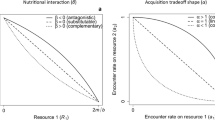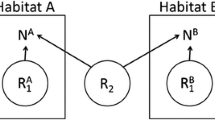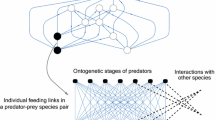Abstract
Species coexistence involving trophic interactions has been investigated under two theoretical frameworks—partitioning shared resources and accessing exclusive resources. The influence of body size on coexistence is well studied under the exclusive resources framework, but has received less attention under the shared-resources framework. We investigate body-size-dependent allometric extensions of a classical MacArthur-type model where two consumers compete for two shared resources. The equilibrium coexistence criteria are compared against the general predictions of the alternative framework over exclusive resources. From the asymmetry in body size allometry of resource encounter versus demand our model shows, counterintuitively, and contrary to the exclusive resource framework, that a smaller consumer should be competitively superior across a wide range of supplies of the two resource types. Experimental studies are reviewed to resolve this difference among the two frameworks that arise from their respective assumptions over resource distribution. Another prediction is that the smaller consumer may have relatively stronger control over equilibrium resource abundance, and the loss of smaller consumers from a community may induce relatively stronger trophic cascades. Finally, from satiating consumers’ functional response, our model predicts that greater difference among resource sizes can allow a broader range of consumer body sizes to coexist, and this is consistent with the predictions of the alternative framework over exclusive resources. Overall, this analysis provides an objective comparison of the two alternative approaches to understand species coexistence that have heretofore developed in relative isolation. It advances classical consumer–resource theory to show how body size can be an important factor in resource competition and coexistence.




Similar content being viewed by others
References
Abrams PA, Holt RD (2002) The impact of consumer–resource cycles on the coexistence of competing consumers. Theo Pop Biol 62:281–295
Abrams PA, Shen L (1989) Population dynamics of systems with consumers that maintain a constant ratio of intake rates of two resources. Theo Pop Biol 35:51–89
Armstrong RA, McGehee R (1980) Competitive exclusion. Am Nat 115:151–170
Bagchi S, Mishra C, Bhatnagar YV (2004) Conflicts between traditional pastoralism and conservation of Himalayan ibex (Capra sibirica) in the Trans-Himalayan mountains. Anim Conserv 7:121–128
Bagchi S, Ritchie ME (2010) Introduced grazers can restrict potential soil carbon sequestration through impacts on plant community composition. Ecol Lett 13:959–968
Baldi R, Pelliza-Sbriller A, Elston D, Albon SD (2004) High potential for competition between guanacos and sheep in Patagonia. J Wildl Manage 68:924–938
Basset A, DeAngelis DL (2007) Body size mediated coexistence of consumers competing for resources in space. Oikos 116:1363–1377
Belovsky GE (1986) Optimal foraging and community structure: implications for a guild of generalist grassland herbivores. Oecol 70:35–52
Bøhn T, Amundsen P (2001) The competitive edge of an invading specialist. Ecol 82:2150–2163
Brown JH, Gillooly JF, Allen AP, Savage VM, West GB (2004) Toward a metabolic theory of ecology. Ecol 85:1771–1789
Calder WA (1984) Size, function, and life history. Harvard University Press, Cambridge
Case TJ, Casten RG (1979) Global stability and multiple domains of attraction in ecological systems. Am Nat 113:705–714
Case TJ, Faaborg J, Sidell R (1983) The role of body size in the assembly of West Indian bird communities. Evol 37:1062–1074
Chesson P (1990) MacArthur's consumer–resource model. Theo Pop Biol 37:26–38
Connell JH (1983) On the prevalence and relative importance of interspecific competition: evidence from field experiments. Am Nat 122:661–696
Dayan T, Simberloff D (1998) Size patterns among competitors: ecological character displacement and character release in mammals, with special reference to island populations. Mamm Rev 28:99–124
de Merona B, Rankin-de Merona JM (2004) Food resource partitioning in a fish community of the central Amazon floodplain. Neotrop Ichthyol 75–84
Duffy JE, Harvilicz AM (2001) Species-specific impacts of grazing amphipods in an eelgrass-bed community. Mar Ecol Prog Ser 233:201–211
Duffy JE, Richardson JP, Canauel EA (2003) Grazer diversity effects on ecosystem functioning in seagrass beds. Ecol Lett 6:637–645
Farnsworth KD, Focardi S, Beecham JA (2002) Grassland–herbivore interactions: How do grazers coexist? Am Nat 159:24–39
Grant PR (1999) Ecology and evolution of Darwin's finches. Princeton University Press, Princeton
Hansen RM, Mugambi MM, Bauni SM (1985) Diet and trophic ranking of ungulates of the northern Serengeti. J Wildl Manage 49:823–829
Harris RB, Miller DJ (1995) Overlap in summer diets of Tibetan plateau ungulates. Mammalia 59:197–212
Holt RD (1977) Predation, apparent competition and structure of prey communities. Theo Pop Biol 12:197–229
Hsu SB, Hubbell SP (1979) Two predators competing for two prey species: an analysis of MacArthur's model. Math Biosci 47:143–171
Huisman J, Weissing FJ (1999) Biodiversity of plankton by species oscillations and chaos. Nature 402:407–410
Hutchinson GE (1959) Homage to Santa Rosalia or why are there so many kinds of animals? Am Nat 93:145–159
Huxley J (1942) Evolution: the modern synthesis. Harper, New York
Kiltie RA (1988) Interspecific size regularities in tropical felid assemblages. Oecol 76:97–105
Krivan V (1996) Optimal foraging and predator–prey dynamics. Theo Pop Biol 49:265–290
Krivan V, Sikder A (1999) Optimal foraging and predator–prey dynamics II. Theo Pop Biol 55:111–126
León JA, Tumpson DB (1975) Competition between two species for two complementary or substitutable resources. J Theor Biol 50:185–201
MacArthur RH (1969) Species packing, and what interspecies competition minimizes. Proc Nat Acad Sci 64:1369–1371
MacArthur RH (1970) Species packing and competitive equilibrium for many species. Theo Pop Biol 1:1–11
MacArthur RH, Levins R (1967) The limiting similarity, convergence and divergence of co-existing species. Am Nat 101:377–385
Obrycki JJ, Giles KL, Ormond AM (1998) Interactions between an introduced and indegenous coccinellid species at different prey densities. Oecol 117:279–285
Owen-Smith N, Novellie P (1982) What should a clever ungulate eat? Am Nat 119:151–178
Persson L (1985) Asymmetrical competition: are larger animals competitively superior? Am Nat 126:261–266
Peters RH (1983) The ecological implications of body size. Cambridge University Press, Cambridge
Prins HHT, Olff H (1998) Species richness of African grazer assemblages: towards a functional explanation. In: Newberry DM, Prins HHT, Brown ND (eds) Dynamics of tropical communities. Blackwell, London, pp 449–490
Ray JC, Sunquist ME (2001) Trophic relations in a community of African rainforest carnivores. Oecol 127:395–408
Reinthal PN (1990) The feeding habits of a groups of herbivorous rock-dwelling cichlid fishes (Cichlidae: Perciformes) from Lake Malawi, Africa. Environ Biol Fishes 27:215–233
Ritchie ME (2002) Competition and coexistence in mobile animals. In: Sommer U, Worm B (eds) Competition and coexistence. Springer, Berlin, pp 112–135
Ritchie ME (2010) Scale, heterogeneity, and the structure and diversity of ecological communities. Monographs in Population Biology 45. Princeton University Press, Princeton
Ritchie ME, Olff H (1999) Spatial scaling laws yield a synthetic theory of biodiversity. Nature 400:557–560
Ritchie ME, Tilman D (1992) Interspecific competition among grasshoppers and their effect on plant abundance in experimental field environments. Oecol 89:524–532
Ritchie ME, Tilman D (1993) Predictions of species interactions from consumer–resource theory: experimental tests with grasshoppers and plants. Oecol 94:516–527
Savino JF, Kolar CS (1996) Competition between nonindigenous ruffe and native yellow perch in laboratory studies. Trans Am Fish Soc 125:562–571
Schoener TW (1968) The Anolis lizards of Bimini: resource partitioning in a complex fauna. Ecol 49:704–726
Schoener TW (1983) Field experiments on interspecific competition. Am Nat 122:240–285
Schoener TW (1976) Alternatives to Lotka–Volterra competition: models of intermediate complexity. Theo Pop Biol 10:309–333
Schröder A, Nilsson KA, Persson L, van Kooten T, Reichstein B (2009) Invasion success depends on invader body size in a size-structured mixed predation-competition community. J Anim Ecol 78:1152–1162
Shurin JB, Borer ET, Seabloom EW, Anderson K, Blanchette CA, Broitman B, Cooper SD, Halpern BS (2002) A cross-ecosystem comparison of the strength of trophic cascades. Ecol Lett 5:785–791
Strobeck C (1972) N species competition. Ecol 54:650–654
Teder T, Esperk T, Remmel T, Sang A, Tammaru T (2010) Counterintuitive size patterns in bivoltine moths: late-season larvae grow larger despite lower food quality. Oecol 162:117–125
Vandermeer JH (1993) Loose coupling of predator–prey cycles: entrainment chaos, and intermittency in the classic MacArthur consumer–resource equations. Am Nat 141:687–716
Wilson DS (1975) The adequacy of body size as a niche difference. Am Nat 109:769–784
Worm B, Duffy JE (2003) Biodiversity, productivity and stability in real food webs. Trends Ecol Evol 18:628–632
Yodzis P (1989) Introduction to theoretical ecology. Harper and Row, New York
Yodzis P, Innes S (1992) Body size and consumer–resource dynamics. Am Nat 139:1151–1175
Yoshiyama K, Klausmeier CA (2008) Optimal cell size for resource uptake in fluids: a new facet of resource competition. Am Nat 171:59–70
Acknowledgments
Support was received from National Science Foundation (DDIG DEB-0608287 to SB and DEB-0543398 to MER) and the National Center for Ecological Analysis and Synthesis (to MER) while preparing this manuscript. Additional support was received from Wildlife Conservation Society and Rufford Maurice Laing Foundation (to SB). We benefited from discussions with Charudutt Mishra, Oswald J. Schmitz, and William T. Starmer. We also thank the reviewers and the editors.
Author information
Authors and Affiliations
Corresponding author
Electronic supplementary material
Below is the link to the electronic supplementary material.
ESM 1
(DOC 65 kb)
Rights and permissions
About this article
Cite this article
Bagchi, S., Ritchie, M.E. Body size and species coexistence in consumer–resource interactions: A comparison of two alternative theoretical frameworks. Theor Ecol 5, 141–151 (2012). https://doi.org/10.1007/s12080-010-0105-x
Received:
Accepted:
Published:
Issue Date:
DOI: https://doi.org/10.1007/s12080-010-0105-x




